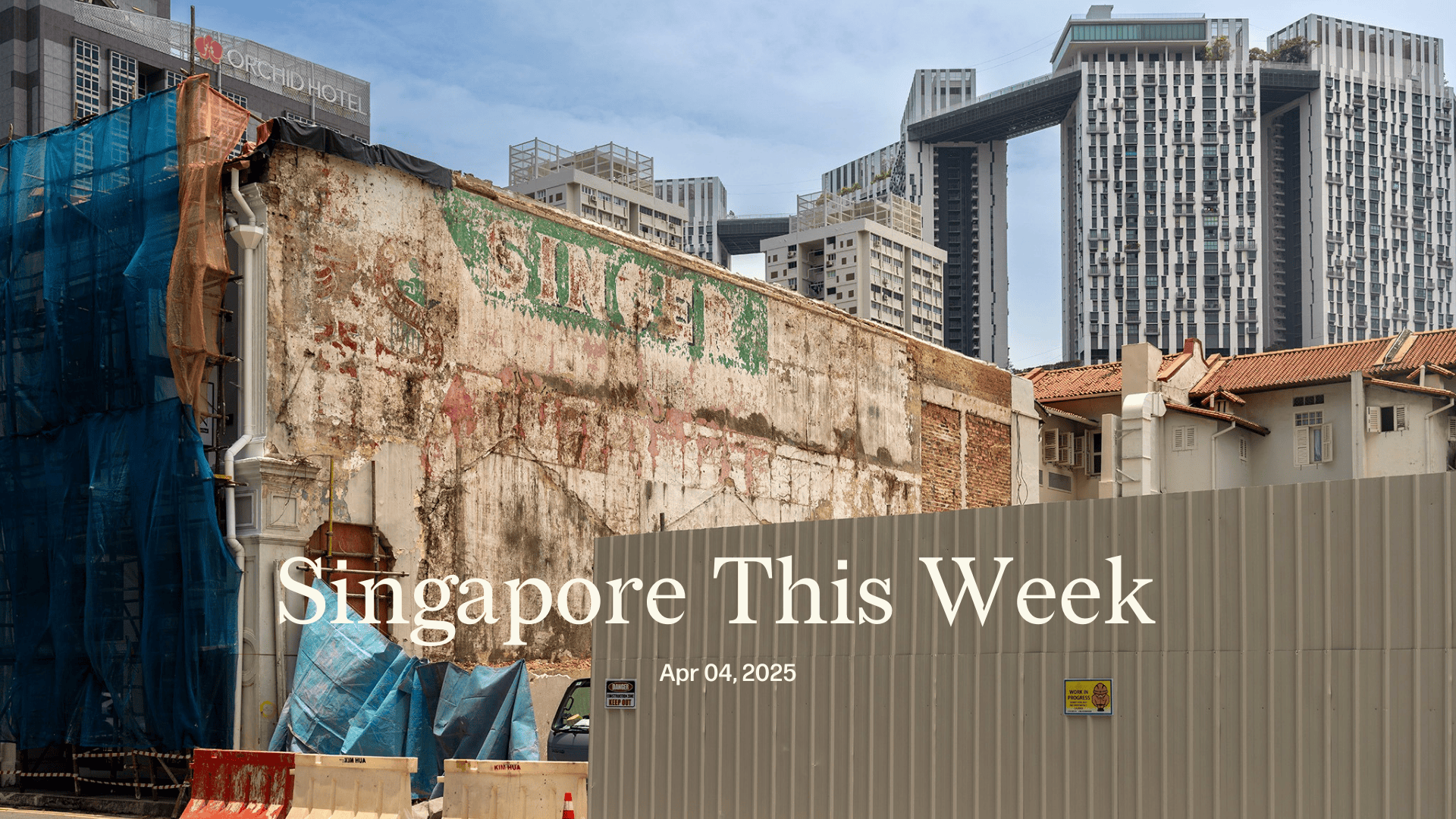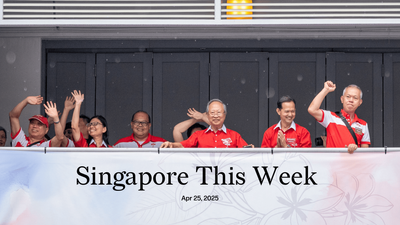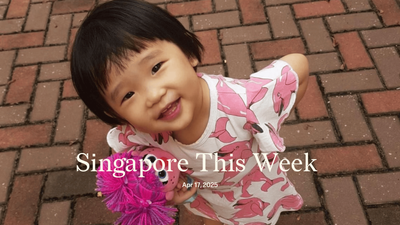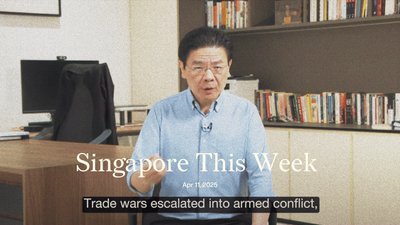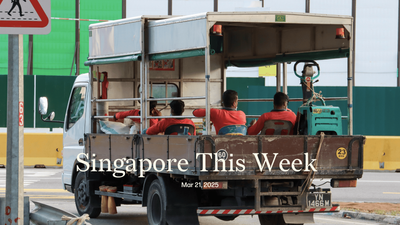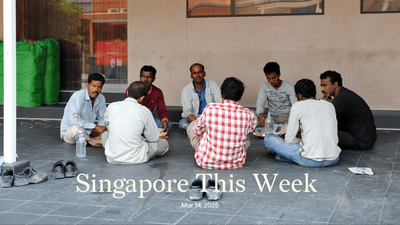Politics: Oops!…I Did It Again
Singaporeans reacted in different ways to the two activists from the Monday of Palestine Solidarity (MPS) group who approached K Shanmugam, law and home affairs minister, at his meet-the-people session. Calvin Cheng, a former nominated member of Parliament and current honorary consul of Serbia to Singapore, splashed photographs of the women and their comrades across his popular Facebook page. He also offered business class tickets to their leaders for them “to re-locate to Gaza, expenses paid by me. But only if they never come back.” For their 928 followers, he offered to buy shoes so they can “take a slow hike” to Gaza. Cheng, a notable firebrand supporter of the ruling People’s Action Party (PAP), has a long history of making incendiary statements online. Like with alt-right commentators in the US, these seem less like meaningful contributions to discourse than just dopamine hits for him, and shits-and-giggles for his bro-ish followers. Bigotry is rife in the comments. Whatever his motivations, for a diplomat to suggest exiling close to 1,000 citizens is morally reprehensible.
But his damage to the party didn’t end there. MPS reported that Tan Kiat How and Vivian Balakrishnan, two ministers, had appeared to “Like” Cheng’s post, thereby offering legitimacy to this suggestion at the highest level. When MPS approached Tan, he said he “may have accidentally” done so—whoopsee!—and proceeded to “Unlike” it. Balakrishnan unliked it after MPS called him out, initially without comment. But late on Tuesday night, perhaps feeling the groundswell of disgruntlement in the Muslim community, Balakrishnan was forced into his own admission: he didn’t like it, he doesn’t share those views, and he’s “since taken measures to enhance account security”. On Wednesday, Balakrishnan, who’s the minister of foreign affairs, let’s not forget, reported the incident to Meta, Facebook’s parent, claiming unauthorised activity.
So this is the reality that Singaporeans must accept. It’s acceptable for a diplomat to offer to exile citizens whose peaceful actions he doesn’t like, and to entertain bigotry on his page. A minister can “accidentally” like problematic posts online. And the minister for foreign affairs’ social media accounts might have been hacked to make it appear as if he had liked a PAP supporter’s post. The whole incident is reminiscent of the time in 2016 that Ho Ching, former boss of Temasek and key party cadre, posted a photo of a monkey with a middle finger on Twitter. (Aside: no outrage, of course, when Ho deploys the middle finger.) It was seemingly in response to the late Lee Wei Ling, her sister-in-law, as part of the siblings’ squabble. Ho apologised, claiming to be a “Twitter newbie”. The ruling elite may think that all this is funny. But the danger is that more and more Singaporeans conclude that they’re taking us for fools.
Society: Tensions brewing
For some Muslim Singaporeans, Hari Raya weekend conversations were tainted with Cheng’s unwelcome persona, as the fallout from his suggestion to exile almost 1,000 Palestinian sympathisers here intensified. Mohamed Jufrie bin Mahmood, a former opposition politician, was the most prominent one to accuse him of Islamophobia, also filing a police report against him for several allegedly bigoted statements over the years. Amidst the negativity, Cheng announced with much fanfare—”Selamat Hari Raya Aidilfitri! Eid Mubarak!”—a S$200,000 gift to Tampines Hub, raised from “my wealthy new citizen friends (formerly from the PRC)”, and intended for “needy citizens”. He claimed to have decided this after speaking with “our Malay Muslim leaders”. Though some expressed appreciation, many were skeptical about attempts to ingratiate himself with the community. “Can’t buy integration,” said one commenter. “A genuine ‘I apologise’ means more than any superficial PR effort ever could,” said another.
The embers appeared to be dying before Balakrishnan’s post late on Tuesday reignited the fire. Jay Ishaq Rajoo, a popular video commentator, was one of many to interrogate Balakrishnan’s vacuous explanation and call for further action against Cheng. Cheng subsequently threatened Jufrie and others with legal action for allegedly defamatory statements. Jufrie responded with an inflammatory post that bizarrely insinuated a connection between the genocide of Muslims by Serbs during Yugoslavia’s balkanisation in the 1990s, and the appointment of Cheng, alleged Islamophobe, as Serbia’s honorary consul to Singapore. Last night, Jufrie filed a second police report against Cheng, and amended an error in his first. “Should he still decide to proceed with his legal intimidation I am prepared to meet him in court,” said Jufrie.
Facing much pressure from the community, Masagos Zulkifli, the minister-in-charge of Muslim affairs, emerged from his shell last night to express disagreement with Cheng’s comments and announce a reversal of the donation: “Calvin has said that it might be better if he redirects the funds for other causes. I appreciate his gesture.” Many Muslims are upset with their leaders for apparently speaking so sweetly to Cheng, having only just harshly condemned the two young hijabis for actions that seem far less provocative. (Maintain adab, grace, during Ramadan, they stressed, infusing their paternalistic chiding with religious notes.) If tensions are still brewing heading into the imminent general election, it’s the PAP that stands to benefit from a possible flight-to-safety vote by the Chinese majority. Opposition politicians, like Red Dot United’s Ravi Philemon, will try to shift focus back to cost-of-living issues and the class divide, around which the PAP is more vulnerable. Whatever the case, we hope that calmer heads prevail in the days ahead.
Some further reading: “The parts we leave out”, the response by Jom’s editorial team to the brouhaha involving Shanmugam and the two activists.
Sign up for Jom’s weekly newsletter
Our newsletters combine weekly updates about Singapore with a “build-in-public” narrative, in which we tell readers about our start-up journey.
No spam. Unsubscribe anytime.
Society: Women in medicine—a timeline in quotes
“Women…are by nature endowed with tender emotion and are physiologically so conditioned that their usefulness in the struggle for existence is strictly limited.”—Dr Lim Boon Keng, physician and reformer, 1907.
A “perceptible change” is happening in Singapore. Parents are more aware of the “benefits derived from the little liberty and education which they allow their daughters.”—Dr Lee Choo Neo, Singapore’s first practising female doctor, 1913.
“He said it was very tough for a woman to become a good doctor as she had to be a wife and a mother…Female graduates were very choosy…They did not want to do this or to do that and those in out-patient clinics were watching the clock.”—The views of Toh Chin Chye, health minister, on the one-third cap on female enrolment in medicine at NUS, as reported by The Straits Times (ST), 1979.
“You have branded us, one and all, as ‘clockwatchers’…and said to the people, without justification, that we are fussy and choosy, when we are struggling to serve to the best of our ability,”—letter sent by 147 female doctors, with support from 113 male colleagues, to Toh, 1979.
“Is it not time for the minister to review this anachronistic [quota] policy?”—Dr Kanwaljit Soin, nominated member of Parliament, 1994. (The government rejected her plea.)
“Feedback from the public sector healthcare clusters confirms that there is no significant problem in deploying female doctors nowadays. Female doctors also no longer avoid working in specialties with irregular hours. The NUS female medical student quota would therefore be abolished”—Ministry of Health, 2002.
2024—NUS enrolled its largest proportion of women in medicine, 60 percent of its new class.
Look how far we’ve come. And, in other ways, look how far we have to go.
International: Quake diplomacy
Just when you thought things couldn’t get worse for Myanmar. Crippled by four years of armed conflict, a severe food crisis, and an embattled economy, seismic waves further dismantled the country’s landscape: cracking facades, collapsing buildings, and crumpling infrastructure; leaving thousands dead and hundreds injured, as well as countless of people trapped under the rubble and homeless, without electricity.
If the international community appeared to have increasingly isolated Myanmar and its ruling military junta, the devastation has triggered a massive humanitarian outpouring from around the world, thereby unclogging diplomatic channels. Singapore, amongst several major aid contributors, joined other Association of Southeast Asian Nations (ASEAN) members in a show of solidarity. Besides seeding $150,000 in the Singapore Red Cross’s fundraising appeal, which raised nearly S$1.5m to support emergency efforts in Myanmar and Thailand, the city-state deployed an 80-member Singapore Civil Defence Force contingent to assist search and rescue operations. The Republic of Singapore Air Force also delivered nine tonnes of essential relief supplies from the ASEAN Coordinating Centre for Humanitarian Assistance on Disaster Management.
It’s heartening to witness the camaraderie between Singapore and its neighbours in times of need, particularly in a region prone to natural disasters and other humanitarian crises. Given the shifting world order and ongoing challenges to stability in South-east Asia—the civil unrest in Myanmar; territorial disputes in the South China Sea; an escalating US-China rivalry; transnational crime; intra-ASEAN conflicts and tensions—the imperative to maintain regional security and cohesion is stronger than ever. In the wake of the quake, Vivian Balakrishnan, foreign minister, called for an immediate ceasefire to facilitate rescue efforts. Last December, in a meeting with ASEAN foreign ministers, he said that freeing Aung San Suu Kyi “is vital for national reconciliation”.
Singapore’s primary aid contributions have historically focused on humanitarian assistance and disaster relief. But there’s perhaps more room for deeper engagement and leadership, such as by spearheading longer-term initiatives in our neighbourhood that tackle climate change and sustainable development.
You can support earthquake relief efforts in Myanmar by donating to a fundraiser organised by a Burmese collective in Singapore, or two international gofundme efforts (here and here) that have been vetted by many Burmese.
Some further reading: In “Is Singapore being used to finance wars?” we examine how global plutocrats have long regarded Singapore as a safe haven for their investments, with recent revelations pointing to illicit flows that are possibly far more nefarious in nature.
History weekly by Faris Joraimi
The demolition of a nine-storey building along Peck Seah street to make way for a new hotel has uncovered a large, old mural of the Singer company logo on a wall that has not seen the light of day for over half a century. Darren Soh, urban photographer, estimated that the mural could be up to 80 years old. The demolished Nehsons building, which stood since 1972, was built right up to that wall, part of a shophouse that was once the headquarters of the Singer company. Famous for its sewing machines, Singer’s logo—and the one on the mural—featured a woman operating a sewing machine, superimposed by a big red letter “S”.
In the decades after world war two, almost every Singaporean home had a Singer sewing machine because of its attractive pricing model; a manual Singer (also called a hand-and-treadle machine) that was operated by a foot pedal could be rented for 12 dollars a month, while an accompanying electric motor cost 10 dollars a month. There was even a five-day free trial to use it at home without any obligation to purchase. With this technology, women in Singapore were able to more easily and quickly perform manual tasks: old curtains or unused fabric could be made into garments; torn clothes could be repaired more quickly. But beyond domestic science, sewing machines enabled greater financial freedom. This was an era before off-the-rack shopping, so women could earn money tailoring dresses or shirts, with designs borrowed from magazines and guides for seamstresses.
Karl Marx attacked this “decisively revolutionary machine” for making garment mass-production more exploitative, especially in overcrowded factories which adopted it. Yet it also shaped everyday life and the role of women as we now know them. Entering homes as an appliance across Asia, sewing machines produced the modern woman, through Singer’s own gendered marketing that promoted virtue and modesty, but also women as consumers who could materialise new styles on display in fashion magazines. With Singer’s extensive branding, the sewing machine itself became an object of consumer longing. Singapore’s story of “modernisation” involves more than industrialisation and infrastructure; it’s also about small changes in our homes, how we dress, and the things we desire. That a reminder of this is visible on a wall, soon to be covered up by a 13-storey hotel, feels like a dense metaphor. One image of historical progress, a conserved shophouse facade next to a sparkling new building, will be clearly seen, while another lies hidden in-between.
Arts: A rich history
One hundred thousand Singapore dollars. That’s the handsome new sum for the NUS Singapore History Prize, given out every three years. Historians aside, playwrights, performers, producers and publishers can also rejoice. The doubling of the already-abundant prize money isn’t the only significant change to the award, funded since 2014 by an anonymous benefactor. It’s now accepting submissions for a wide range of artforms, from podcasts to performances, part of a push to make Singaporean history more accessible to non-academic audiences. There aren’t any limits on the work’s production date, so long as it proffers “new insights or new ways of exciting the imagination of Singaporeans about Singapore’s history”. (The work also has to be in English, or translated into it.) Khir Johari’s The Food of Singapore Malays: Gastronomic Travels Through the Archipelago was the most recent prizewinner, a tour de force that is both celebration and reclamation of the cuisine of the Nusantara. The 600-page tome wasn’t a conventional monograph, and didn’t try to be, signalling the judges’ desire to recognise contributions outside of formal academia. From the pounding of sambal to the fermenting of shrimp, the book explores the food of the Malays as medicine and magic, as indigeneity and ingenuity.
What other historical narratives, told by Singaporean artists, might rival Khir’s historical contributions in scope and scale? Jom would like to humbly offer a few nominations to the panel of judges for their consideration. There’s Drama Box’s stunning “It Won’t Be Too Long: The Cemetery (Dawn & Dusk)”, where the living communed with the histories of the dead in the sacred and scarred Bukit Brown Cemetery. Staged in the wake of a national debate around its fate, audiences woke at 4am, and were bussed to a verdant clearing in the burial grounds for “Dawn”, an atmospheric candle-lit performance-vigil; as the sun rose, it also dawned on us that the shadows in the green undergrowth weren’t spirits or shrubs, but excavators and trucks. That same evening, at “Dusk”, audiences would witness the life and death of the cemetery through a different lens: a documentary theatre performance meticulously assembled from real-life interviews, press conferences, newspaper reports and archival materials, portraying the drawn-out struggle between activists and the state over the cemetery’s fate. Then there’s Teater Ekamatra’s metahistorical “Tiger of Malaya”, where a rag-tag group of actors from Singapore and Japan attempt to remake the Japanese propaganda film of the same name. What ensues is a harrowing and morbidly humorous counterfactual retelling of both countries’ world war two histories. It’s also a pointed interrogation of what historical representation really means when accounting for power asymmetries in race and military might. Like the play, it’s thrilling to see the NUS Singapore History Prize ask, through their expanded solicitation of nominations, whether the textual archive is ever a stable record of our past.
Arts: Cinema inferno
If we thought bookstores had it bad, perhaps cinemas have it worse. Or perhaps this isn’t a competition either constituency wants to win. The credits rolled for two cinemas here last month: the indie outfit Filmgarde Cineplexes and a Cathay Cineplex outlet, run by mm2 Asia, at Jem shopping mall. Both operators had been forced to fold up several cinemas over the past few years, resigning themselves to rising rental costs and changing consumer habits—not helped by the pandemic tipping point that pushed patrons, en masse, to online streaming platforms. While Cathay Cineplexes still has four outlets left, it’s also received letters of demand from its landlords at Causeway Point and Century Square for about S$2.7m in rental arrears and legal costs, in addition to the S$4.3m it owes Jem’s Lendlease Reit.
These cumulative closures are the practical symptoms of larger existential ills in the film industry, with audiences frustrated by endless sequels and engorged franchises, and overwhelmed by the constant churn of content creation. Derek Thompson, writing about the cataclysm of our “anti-social century” for The Atlantic, also pointed out that film has transformed from a “necessarily collective experience” into a “home delivery system”, from “a ritual of togetherness into an experience of homebound reclusion and even solitude”. Where strangers could once experience films alone, together, they’re now viewing them alone and apart. Filmgarde Cineplexes managed a hopeful message for its fans on social media: “The cinematic experience at its best, can be cathartic and magical, and it is our hope that future generations of Singaporeans will continue to walk into the cinemas to feel this for themselves, and to encourage Singapore talent to keep making films, one step at a time.” It’s a sentiment that’s been repeated by filmmakers and staunch cinemagoers everywhere. “This is my battle cry,” director Sean Baker said during his Oscar acceptance speech for his low-budget, critically-acclaimed “Anora”, earlier this year. “Filmmakers, keep making films for the big screen.” But can they, if there aren’t any big screens left?
Business: From tech company to taxi company
Having raised a whopping US$10.4bn (S$14bn) to presumably conquer the tech SuperApp world, what has Grab gone on to create? Surprise, a decidedly old-school business: a taxi company. Singapore’s Land Transport Authority (LTA) has granted Grab a Street-hail Service Operator License, allowing its subsidiary, GrabCab, to operate taxis alongside its existing ride-hailing services. The 10-year license, effective April 9th, makes Grab Singapore’s sixth taxi operator, alongside established players like ComfortDelGro and Trans-cab.
Under the new license, GrabCab taxis can be both hailed on the street and booked through an app, unlike private-hire vehicles, which are restricted to the latter. Grab has three years to grow its fleet to at least 800 taxis, a gradual ramp-up compared to traditional operators.
This move follows Grab’s failed 2024 attempt to acquire Trans-cab, which was withdrawn after regulatory scrutiny. While the expansion strengthens Grab’s multi-service ecosystem, it also raises questions about competition and market saturation. Will more taxis improve availability, or simply add to congestion? Or worse still, further reduce drivers’ earnings?
Tech: Advancing Singapore’s foundry frontiers
Taiwanese chipmaker UMC’s new US$5bn (S$6.7bn) semiconductor facility in Singapore will produce 30,000 wafers monthly from next year using the most advanced foundry processes. These wafers will power the latest generation of smartphone displays and batteries, and are also critical technology for automotive, IoT, and AI applications. UMC’s investment is a huge boost to Singapore’s supply chain diversification efforts. Over the next few years, this expansion is estimated to create over 700 jobs locally, particularly in research and development engineering.
UMC’s expansion mirrors moves by peers like GlobalFoundries and Micron to reduce reliance on Taiwan and China, where natural disasters and geopolitical tensions pose risks. The global semiconductor landscape has become intensely competitive in recent years due to AI’s ascent and increasing US-China tensions. With the Trump administration announcing blanket 5434 percent tariffs on Chinese goods, these tensions are bound to worsen. This may lead to cross-border consolidation, as exemplified by the ongoing rumors of a potential merger between US-based chipmaker GlobalFoundries and UMC (which has denied them). If this becomes a trend, and the American semiconductor footprint here keeps growing, it may impact Singapore’s ability to maintain its cherished neutrality towards the two superpowers.
Tech: Deepening Singapore-Japan ties
NUS Enterprise is expanding its presence in Japan with a second BLOCK71 hub in Tokyo, following the 2024 launch of the first one in Nagoya. In partnership with Central Japan Innovation Capital (CJIC), Kyoto University and TIS Inc., the initiative hopes to boost cross-border deep tech innovation and revive Japan’s startup ecosystem. Block71 Tokyo will connect sustainability, robotics, and smart health startups from South-east Asia with Japan’s tech giants and investors. Already, Singapore firms like RoPlus and M.I. Cloud credit the Nagoya immersion programs for securing Japanese partnerships. Block71 Tokyo will also support Japanese firms looking to expand in South-east Asia. As part of this, Kyoto University will send its startups to join the NUS Graduate Research Innovation Programme, thus combining research prowess with pathways to commercialisation.
Can NUS Enterprise replicate its Singapore success in Japan’s insular market? Cultural hurdles remain, but with Japan desperate for startup revitalisation, the timing is ripe. For South-east Asian founders eyeing Japan—and vice versa—BLOCK71’s dual hubs may be the launchpad they need.
Correction notice: A previous version referred to Calvin Cheng as honorary consul to Serbia and a Singaporean diplomat.
If you enjoy Jom’s work, do get a paid subscription today to support independent journalism in Singapore.


